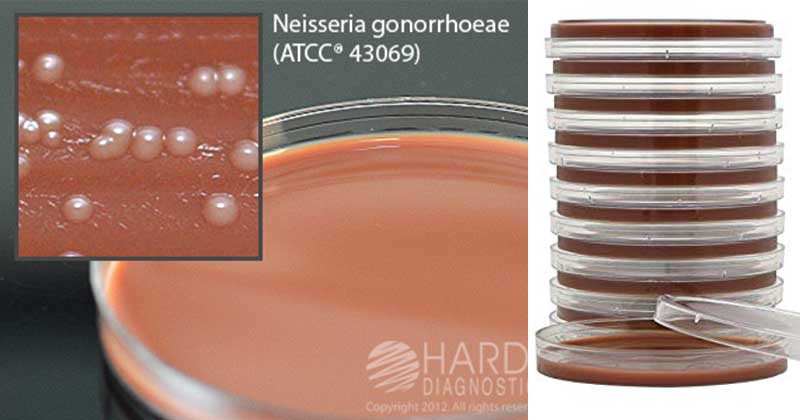Thayer and Martin reported an improvement of the Chocolate Agar formulation that contained antimicrobics vancomycin, colistin and nystatin have been added to minimize overgrowth by contaminants, suppress the growth of saprophytic Neisseria sp., and enhance the growth of pathogenic Neisseria. Martin and Lester later added antibiotic trimethoprim to make the medium further selective and shown to be of value in the suppression of Proteus spp. Trimethoprim lactate refrains Proteus swarming. The resulting medium is called Modified Thayer Martin. It is a selective and enriched medium for the isolation and cultivation of Neisseria sp. from mixed flora with suppression of most other gram-negative diplococci, gram-negative bacilli, gram-positive organisms, and yeast.

Image Source: Hardy Diagnostic
Interesting Science Videos
Composition of Modified Thayer Martin Agar
| Ingredients | Amount |
| Casein peptone | 7.5g |
| Meat peptone | 7.5g |
| Corn Starch | 1.0g |
| Dipotassium Phosphate | 4.0g |
| Monopotassium Phosphate | 1.0g |
| Sodium Chloride | 5.0g |
| Agar | 12.0g |
| Hemoglobin solution | 10.0g |
| IsovitaleX enrichment | 10.0ml |
| Vancomycin | 300μg |
| Colistin | 750μg |
| Nystatin | 12,50 U |
| Trimethoprim | 5.0mg |
| Demineralised water | 1000.0ml |
Final pH=7.2 ± 0.2 at 25°C
IsovitaleX enrichment
| Dextrose | 100.0g |
| Vitamin B12 | 0.01g |
| L-Glutamine | 10.0g |
| Thiamine HCl | 0.003g |
| L-Cystine | 1.1g |
| Adenine | 1.0g |
| p-aminobenzoic acid | 13.0g |
| Cocarboxylase | 0.1g |
| Cystine HCL | 25.9g |
| Guanine HCL | 0.03g |
| NAD | 0.25g |
| Ferric nitrate | 0.02g |
| Demineralized water | 1000.0ml |
Preparation of Modified Thayer Martin Agar
- Preparation of the GC Agar base
- Add components of GC medium base into distilled water and bring volume to 730.0ml. Mix well thoroughly. Gently heat until boiling. Autoclave at 121°C for 15 minutes. Cool to 45-50°C.
- Preparation of Hemoglobin solution
- Add hemoglobin to distilled water and bring volume to 250.0ml. Mix thoroughly. Autoclave at 121°C for 15 minutes. Cool to 45-50°C.
- Preparation of IsoVitaleX enrichment (10ml)
- Add components to distilled water and bring volume to 10.0ml. Mix thoroughly. Filter sterilize.
- Preparation of VCNT antibiotic solution (10ml)
- Add components to distilled water and bring volume to 10.0ml. Mix thoroughly. Filter sterilize.
- Preparation of the medium
- To 730.0ml of cooled, sterile GC agar base, aseptically add 250.0ml of sterile hemoglobin solution. 10.0ml of IsoVitaleX enrichment and 10.0ml of VCNT antibiotic solution. Mix thoroughly and pour into sterile Petri dishes or distribute into sterile tubes.
Principle of Modified Thayer Martin Agar
Modified Thayer-Martin Agar is based on Chocolate II Agar, which contains an improved GC Agar base, bovine hemoglobin, and Enrichment. The GC II base contains nitrogenous nutrients in the form of casein and meat peptones, phosphate buffer to maintain pH, and corn starch, which neutralizes toxic fatty acids that may be present in the agar. Dextrose is added to enhance the growth of gonococci. Hemoglobin provides X factor (hemin). IsovitaleX enrichment is a defined supplement that provides V factor (nicotinamide adenine dinucleotide, NAD), vitamins, amino acids, coenzymes, dextrose, ferric ion, and other factors which improve the growth of pathogenic Neisseria. These selective media contain antimicrobial agents, vancomycin, colistin, and nystatin (V-C-N inhibitor) to suppress the normal flora. Vancomycin is active primarily against gram-positive bacteria. Colistin inhibits gram-negative bacteria, including Pseudomonas species. Modified Thayer Martin agar contains which has been proven in the inhibition of the Candida albicans. Trimethoprim lactate refrains the swarming of Proteus species.
Result Interpretation on Modified Thayer Martin Agar
Typical colonial morphology on these media is as follows:
- Neisseria gonorrhoeae: Small, grayish-white to colorless, mucoid with a smooth consistency and defined margins, and are typically 0.5 – 1.0 mm in diameter.
- Neisseria meningitidis: Medium to large, blue-gray, mucoid.
Uses of Modified Thayer Martin Agar
- Thayer-Martin Agar is used for the isolation of pathogenic Neisseria from specimens containing mixed flora of bacteria and fungi.
- It is used to isolate and cultivate Neisseria species.
Limitations of Modified Thayer Martin Agar
- Additional biochemical and serological testing are recommended for the final confirmation.
- Culture for pathogenic Neisseria should be incubated in 3-7% CO2. Higher concentrations of CO2 may be inhibitory to some strains.
- Selective media for pathogenic Neisseria may inhibit other pathogenic bacteria, e.g., Haemophilus.
- The existence of strains of N. gonorrhoeae inhibited by the components of V-C-N Inhibitor and trimethoprim lactate have been reported.
- While “saprophytic” Neisseria are generally suppressed by selective media, the occasional recovery of N. lactamica on Thayer-Martin Selective Agar has been reported.
- Some strains of Capnocytophaga species may grow on these selective media when inoculated with oropharyngeal specimens.
References
- Himedia
- Thermofisher
- Becton, Dickinson and Company
- Hardy Diagnostic
- Thayer JD, Frank PF, Martin JE Jr. (1965). Thayer- Martin selective medium for the cultivation of Neisseria meningitidis from the nasopharynx. Am J Public Health Nations Health. 55(6):923–927.
- Ronald M. Atlas and James W. Snyder (2014). Handbook of media for clinical and public health microbiology. CRC Press. Taylor & Francis Group, LLC. Page no:419-420
